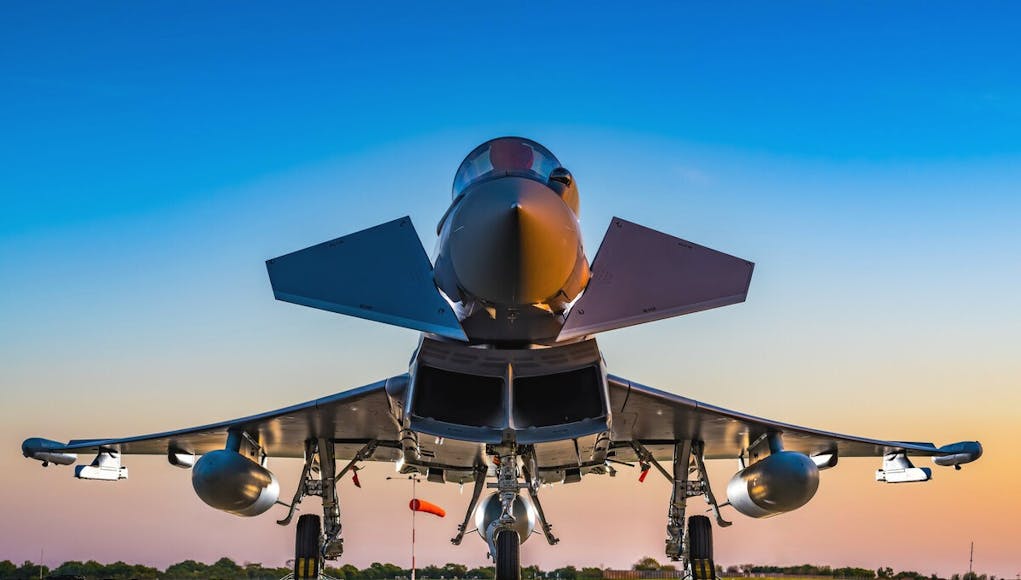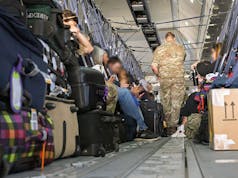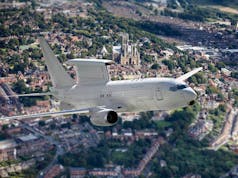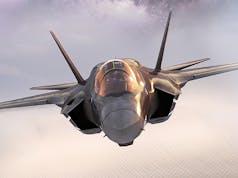BAE Systems has been awarded a contract valued at approximately £135m to improve weapons capability of the Typhoon jet.
The work will increase the variety of precision guided munitions, and further enhance Typhoon’s defensive systems and datalinks, improving high-speed secure sharing of data.
Specifically, the capability enhancement contract termed ‘Phased Enhancement Package 3c’, includes enhancements to Typhoon’s capability when operating the Meteor air-to-air missile, and the Brimstone precision air-to-surface missile, the MIDS Link 16 data link and radio, as well as the defensive aids sub-system (DASS).
BAE Systems say in a release:
“The contract forms part of an ongoing commitment by the Eurofighter consortium and UK, Spain, Italy and Germany to continue to develop Typhoon’s technology-led capability, increase interoperability with coalition forces and mature technologies for the nations’ future combat air systems. Current development work on Typhoon includes the design and exploitation of new large touchscreen cockpit displays, funded by BAE Systems, enabling pilots to assess and respond to increasing volumes of data from the aircraft’s sensors and datalinks. The Typhoon programme directly employs more than 5,000 at BAE Systems, supporting a further 10,000 jobs across the UK economy.”
Richard Hamilton, Typhoon Programme Director, Europe – BAE Systems Air, said:
“This contract marks another significant milestone in the continued development of Typhoon’s capability as we apply our breadth of expertise to further advance its combat air capability, ensuring it has the technologies required for the future battlespace. The contract will sustain 100 highly-skilled engineering roles in the North West and is just one example of a number of technology-led innovations being developed on Typhoon, which will help to keep the UK skill base at the forefront of the global combat air sector and sustainable skills required to deliver the next generation future combat air system.”














I was hoping it would include those conformal fuel tanks that tranche 3 Typhoon are already plumbed for.
Conformal’s died a death a few years ago. They will never happen. When testing them there were significant aerodynamical issues, confirmed by Airbus. The fuel plumbing and attachment points were put in before the full testing was concluded as a hedge.
Best other upgrades would be the LERX, engine upgrade and, for fuel consumption not manoeuverability, would be the thrust vectoring option that was trialled in ground tests. All of these would give massive performance increases but would require extensive testing and dev funding which isn’t going to come. The cockpit, weaponry, radar and EW system upgrades are very welcome though and will make Typhoon exceptionally competitive for years to come.
I have my doubts on thrust vectoring, it would add considerable weight and there were reports that WVR combat the German pilots had ‘Raptor salad’ as they put it with the Typhoon having the advantage and TV causing the Raptor to loose to much energy due to it TV. Now you can sling a missile over your shoulder for combat I can’t see the advantage, but great for airshows. Where it may help is reducing drag as the control surfaces can be set at an optimum for cruising/low drag and use TV to trim the aircraft but with the extra weight not sure there’s much of a saving. Engine upgrade makes most sense not least because technology learnings could transfer to Tempest, like wise with sensors radar and EW. I don’t know why LERX has not moved forward perhaps it adds to the RCS or with the increase manoeuvrability there’s a penalty on air frame life.
For the Raptor, thrust vectoring is not all about dog fighting maneuverability. It also makes supercruising more efficient. But perhaps more significantly it allows the aircraft to fly higher whilst maintaining aerodynamic control. The flight control software gives the the thrust vectoring more authority in pitch and roll, as it gains in altitude. This compensates for the loss of the authority from the wing controls.
The Typhoon like the Rafale can turn inside a F16V, which when clean, can outperform a Raptor in a slow tight fight. The Raptor is really an energy fighter, where it can zoom down from upon high at an unsuspecting target. The Airbus developed aerodynamic improvements would give the aircraft a similar turn performance as the Su27/33, accredited as the most maneuverable fighter.
The “aero package” adds very little to the aircraft’s RCS. It shouldn’t affect the airframe life, but that depends on how the pilot flies it.
Hi Davey. There’s not much info on Typhoons aero package so I was just making logical assumptions as to why its not gone ahead. Another reason I guess some weapons would need to be re-qualified due to airflow changes? On TV its a major change to the Typhoons due to the weight not sure were RR is on variable bypass technology but if we want more range and efficient supper cruise that’s where I’d invest.
In 2015 Airbus flew demonstrator IPA7 aircraft with the wing leading edge extensions and strake extensions fitted. It was flown by UK, German and Italian pilots and did 36 sorties. It increased wing lift by 25%, tightened the turn radius, increased turn rate and faster nose pointability. Airbus also said it was designed for easier weapons integration. The package had been in development since 2010. Both Airbus and BAe were heavily involved, as BAe did the flight control laws modifications to the flight control software. there was a ton of extensive CFD modeling and model wind tunnel testing before it was allowed to fly. Airbus also have a further aero enhancement, where they would extend the length of the trailing edge flaps and elevator, for a larger surface area. Thereby giving more control authority at slow speeds and at height. As far as I know, none of the test aircraft have been modified with the larger flight controls.
Having seen the modifications to IPA7 at the Airbus site in Hamburg. The addition of the strake and LERX look pretty simple mechanically to apply (drilling and riveting). The pilots have said it completely changes the nature and aerobatic performance of the aircraft, significantly for the better. So I’m really surprised nobody has taken up the modification or incorporated it into Germany’s new Tranche 4 aircraft. On a sales point of view, the aero package allows it to trump the Rafale, whereas at present their pretty much on par, where each have pros and cons aerobatically.
As RR was part of the joint project with GE producing the F136 engine, that was supposed to be the alternative for the P&W F135 for the F35. The F136 was based on the earlier F120 engine used in the YF22 and YF23 prototypes. The F120 engine had a pretty basic variable bypass ratio, the F136 engine was the next evolutionary step. At Filton, RR have shown a EJ200 development test engine with a variable bypass ratio built on the knowledge gained from the F136 engine. It didn’t have any of the other modifications like the new burners, intermediate compressor section, power turbine section or thrust vectoring. They did not show any performance information. But the guys delivering the presentation said it did as expected increased performance and that longevity was not affected, they didn’t expand on that any further. The presentation was part of a tour of the Filton factory I did when I was in DE&S back in 2015.
The Typhoon 3D nozzle installation was incredibly light. Whilst it added manoeuverability, the main benefit was in reducinbg fuel consumption by 7%+ in the cruise.
Nearly every modern version of the F-16 has conformal tanks, so why is it beyond us? If the initial, over bulgy configuration for Typhoon would not work in reality, then go design a slimmer version.
It’s not as simple as design a slimmer version. Aerodynamics, centre of gravity and fly by wire are very complicated. Rafale doesn’t have conformal either.
No matter the aircraft, adding conformal fuel tanks adds mass to the airframe. By adding mass you will alter the flight characteristics of the aircraft, usually making it more sluggish to control movements. The main issue with the tanks is that they are a permanent fit, so unlike drop tanks can’t be got rid of during flight.
The RAF has dones very well and developing the rolling upgrade of the Typhoon. Gone are the discrete mid-life upgrades – creating boom and bust issues for the industry – instead the continued incremental enhancements have created a steady drum beat of work.
I think that this quote, “and mature technologies for the nations’ future combat air systems”, is particularly interesting as it suggests that the link between platform and systems is being broken at last. Too long have specific systems been associated with a particular platform, often leading to delays of the whole programme. Maturing technology on Typhoon prior to Tempest and the Franco German FCAS means both programmes will be derisked.
I think that the RAF is now well placed to push a head with Tempest especially if they can carry across this rolling enhencement approach to the Tempest. I expect to see a basic version of Tempest into service and see its’ capabilities improve as new technology and capabilities mature over its’ life cycle.
Hopefully…
Cheers CR
As ever CR, a well written and accurate assessment.
I totally agree, getting Radar 2 up and running across the trance 2 and 3 fleets has to be a priority after this latest round up of upgrades.
Thanks John,
I agree Radar 2 should applied to the Tranche 2 and 3 airframes, however, if I remember correctly there is only funding for 40 units which means Tranche 3 only I think.
However, if it leads into the Tempest radar then I think it is a sensible compromise between capability enhancement over the long term and cost.
Certainly, the Tranche 3 airframes will be very good air defenders. So the T2’s will be the Hurricanes and the T3’s the Spitfires 🙂
Cheers CR
Based on the PR released so far from Team Tempest it looks like we have already advanced well beyond Radar 2 and the Typhoon engine. It seems whatever learning was had from those Typhoon programs was applied some time ago for Tempest by Leonardo and RR respectively.
https://www.rolls-royce.com/media/press-releases/2020/15-10-2020-latest-uk-technology-revealed-for-a-ground-breaking-combat-aircraft.aspx
This details just how far back RR started on development for the Tempest engine – 2014.
https://www.rolls-royce.com/media/press-releases/2020/09-01-2020-rr-develops-world-first-electrical-technology-for-next-generation-tempest-programme.aspx
Hi Glass Half Full,
Thanks for the links, much appreciated. I had seen them both before but it was good to remind myself of the details.
I would say that the first link highlights a lot of stuff that is ‘under development’. So I would agree that the aim is to produce something that goes well beyond Radar 2, for example, but reading between the lines it is still along way from actuality.
My point is that as technology is developed for the Tempest, some of it could be applied to the Typhoon system, but it would not be the full Tempest spec equipment because I would see it being ‘spun’ out at different stages of the development cycle, if possible. So it would be a half way house development that would allow concepts to be tested on an actual frontline aircraft.
A good example of the possibilities is that some of wearable cockpit tech is already being flight tested on a Typhoon testbed. The Typhoon already has a pretty good helmet mounted display system which, I believe, is capable of supporting line of sight firing of ASRAAM missiles. So I would suggest that there is a possibility of future upgrades to the Typhoon in this area. Again I think the step forward for Typhoon would not be the full on Tempest level of capability as I do not think the rest of the Typhoon systems could support the computing power requirements for a start.
My main hope is that the RAF and contractors build on the experience gained from the Typhoon incremental development programme and see the Tempest as a continuum of those processes. We would also see the Typhoon retain its air superiority edge over many of its likely adversies and the cost of Tempest being spread over two programmes. Also, if Tempest were to be cut, we would get something for our money.
As for early adoption of the engine tech being developed by Rolls Royce, I think it unlikely that it could be shoe horned into the EJ200 as I think it would require significant changes to the engine and the other partners appear to want to spend their money on other priorities. So, sadly, I think this is the least likely of all the stuff being developed for Tempest to see the light of day on Typhoon.
Cheers CR
Hi CR,
We are agreeing I think although I hadn’t picked up on you referring to feeding technology back to Typhoon. My posts were only to highlight that that we’re further along than may be appreciated.
From many of the comments I read it seems there’s a perception that the Tempest program started in mid-2018 when it was announced and has barely progressed since. The reality is many of the core technologies have been in development far longer.
When Tempest was announced there was a strong stress on cost control by both the RAF and BAES and spiral development out of Typhoon was part of that. IIRC there was also a stress on being able to support rapid new system and weapons integration to maintain/enhance capability, something F-35 is clearly failing at presently.
However, as you note the engine for Tempest is significantly different. So any work on EJ200 at this stage is unlikely to feed forward and its not likely to be worth the investment to feed technology back into the EJ200 (or share the IP with other Eurojet engine partners) or plan on replacing EJ200 with a different engine. Radar also seems to fall into a similar category based on what is being described.
Avionics and defensive systems on the other hand would seem more likely to support both forward and backward development and implementation. Which would maintain Typhoon capabilities and support common spares and training across both aircraft.
Excellent take and vital I think if the UK is going to be able to play at the top table with ongoing and future programs so making them work together is more than welcome if a somewhat belated move I think. Separate generally unrelated specialist programmes though I can see the appeal to the forces wanting to eke out every possible advantage but are both a luxury and in the end an anchor on improving capabilities and flexibility overall not to mention the extra costs involved. As in ship building too it’s so good to see an overall long term plan to create ongoing work on programmes that overlap and transform one into the next including one hopes a similar approach now to missiles and other add ons. To an outsider like me it appears to be what for example the US has done with its naval building and a company like Dassault has done with its fighters, that support from Govt and teaming between them and the suppliers for continuous development over specific independent programme blocks seems a vital ingredient and must give confidence for investment and expansion.
Good crit.
That is the son of T31 model of doing things. Although Tempest will be a bit more high end as a platform. The slides from the Danish Defence Procurement on T31 are very interesting as they state this as the whole rationale for the way it was designed and built.
Build a biggish adaptable platform that is agnostic and then add flavouring according to taste.
Hi Supportive Bloke,
Building big is something that the UK has been slow to adopt but we seem to be really taking it to heart in the last 20 years or so. The first platform I am aware of was the Astute SSN, nearly 50% larger than the previous T boats.
The T31’s are the largest example of fit for not with approach to getting things done quickly. IF the RN can then adopt a rolling programme of enhancements for the T31 in a similar fashion to the T45 upgrades, but of a less expensive nature we could see capabilities introduced to the RN’s fleet of GP frigates in step with the rising threats emerging globally. Again being optimistic here, but in line with the fundementals behind the original design that you describe.
It will be interesting to see how the T31 moves forward, but there has been a flurry of orders from the MoD since late last year, so hopefully those trends will continue.
Cheers CR
I think a good example is the Aesa radar, we could have gone for a perfectly good version a few years quicker like the Germans/Spanish have done but quite clearly preferred a class leading version specifically looking towards Tempest over an intermediate solution. Always a fine balance but at long last in that programme after years of dithering and delays some clear thinking and looking to the future to make sure that the benefit for the future far out ways a few years delay now and saves costs and time ultimately.
Hi Spyinthesky,
Your general points above about running long term programmes and effectively exploiting technology developed independently and across the defence programme are at the core of a cost effective equipment acquisition system. It has been the ‘holy grail’ for defence acquisition for decades but proved very ellusive to achieve for all sorts of reasons – there is a book in here somewhere…
However, back in the late 90’s the UK adopted an improved version of the US acquisition system (smart was in the title somewhere if I remember rightly). However, there was a period of regression or push back staring in the late 00’s from my lowly perspective in the big machine. The main looser being the Army. The RAF had Typhoon and they worked very hard to restructure the programme into the ‘smart’ framework, not easy for a legacy programme of such complexity and it took quite sometime to achieve. Once they saw the benefits of the smart way of doing things I think they largly stuck with it and have quietly benefitted from what is one of the better quality Typhoon fleets.
The RN learnt its lesson from the sadly long gestation of the T26 frigates. 20 years or so to argue over the requirements and an aging fleet of T23’s. Not to mention the gapped SSN programme. As such I think there is a generation of RAF and RN officers currently in positions of influence who know only too well what happens if you do not deliver on time, to cost and to quality. It is a great way to focus minds. I suspect the Army is now in embarking on the same lessons learnt process, if not expect to see the Army take more painful hits.
Finally, Dassault – Mirage fighter programme was an awesome achievement, especially in the post war world (Mirage I – 1961).
Cheers CR
Its what F1 does very well, you have next seasons car in development whilst designing, testing and deploying incremental upgrade to this years, then lesson learnt get built into the new car. You all have the eye on the longer term technology changes and have a plan to incorporate these as they mature.
Can’t resist bemoaning the the fact that we’ll shortly be down to 107 Typhoons when Germany is replacing its tranche 1’s as well as some of their Tornados with new models which Spain will also most likely do with their F18’s.
The unit price of the F35 is still dropping and hopefully we’ll be up to around 80 but not until the early 2030’s and by all accounts they are still seriously expensive and complex to operate.
A few tranche 4’s to keep the RAF fleet at 130-140 to properly equip 7 or 8 squadrons and keep airframe hours healthy would have been great to make up for ditching the tranche 1’s and the slow F35 delivery to avoid a fighter gap in our inventory.
Also part of the reason France is arguably doing better at exporting Rafale is that they are still buying new examples and so both display confidence to would be buyers whilst also having a ‘hot’ production line.
Unfortunately, we don’t have the cash to buy more Typhoons, and F35’s and fund Tempest and upgrade the Typhoon fleet we currently have. The radar Mk2 will offer incredible capability, but it won’t be cheap.
Totally agree, I get we have little spare to pay for them, but replacing the early Tranche is needed to keep the fleet at strength.
A smaller fleet will increase the workload on the remaining jets and who knows what
Ops are around the corner that will use up more airframe life, will they make it to 2035 ? Keep the line going, it’s good for the economy and may lead to exports. Let’s not capability gap fast jets…… please!
Good Lord. Looking at the comments, has some positivity broken out on UKDJ for a change?
Well said CR.
Thanks Mate,
I guess I’m just in a positive mood today 😀
Mind you I am impressed with Ben Wallace which is a source of my current optimism. Hopefully, he will be in post for at least the remainder of this parliament. He appears to be capable of making decisions when they are needed. Which is all to the good.
Obviously, the success that appears to be emerging at the moment owes much to the previous emcumbents and the continued efforts of the RN and RAF. Hopefully, being an ex-army officer Wallace will be able to encourage the Army to make similar changes and learn the lessons it so desperately needs to learn.
One point I haven’t yet made is the relationships between the MoD customers and the contractors. The army still has some way to go in establishing an effective relationship with LM, for example, which I suspect is a contributary factor in the current issues around the Ajax. If everyone is comfortable and secure within the working relationship then honest on open dialogue becomes the norm, making it much easier for the contractor to manage expections, resulting in the art of the possible solution. The RAF went through a period of not really getting on with BAE Systems (who didn’t), but overtime they have both managed to develop a good programme of incremental development for the Typhoon. I think the resulting confidence is a key reason the that Tempest even started…
Long may it last.
Cheers CR
With all the development, how does the tranche 4 ordered by Germany compare to the F-35?
£135m for developing anything remotely connected to Military Air Ops is unworthy of comment.
Sums like that can be funded from Petty Cash.
The Float in a Military Fund is probably £1bn.
I know these things – She Who Must Be Obeyed once did accounts, commercially. My applications for routine expenses are issued in pence rather than GB Pounds…….
https://www.instagram.com/p/CSPR_POqQ4y/?utm_medium=copy_link
Typhoon wide area display short demo fie thisecwho are interested